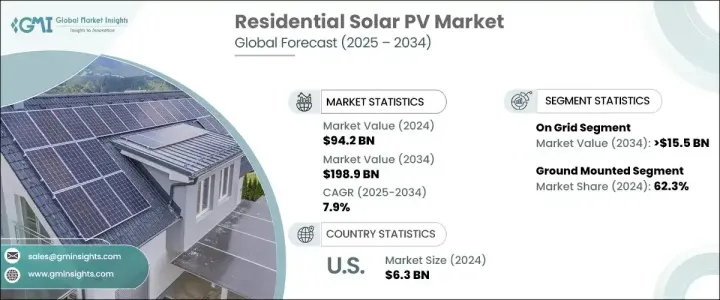
세계의 주거용 태양광 발전(PV) 시장은 2024년에 942억 달러로 평가되었고, 2025년부터 2034년까지 연평균 복합 성장률(CAGR) 7.9%를 나타낼 것으로 예측되고 있습니다.
성장의 원동력이 되는 것은 에너지 비용의 상승, 유리한 정부 정책, 지속 가능한 에너지 솔루션에 대한 소비자의 의식의 고조입니다. 이에 따라 태양광발전기술의 채용이 가속화되고 있습니다.

태양전지의 기술적 진보, 에너지 저장 솔루션의 개선, 스마트 모니터링 시스템의 통합이 시장 침투를 더욱 뒷받침하고 있습니다. 또한 인공지능과 사물인터넷(IoT) 기술의 통합으로 태양광발전시스템의 효율과 성능이 향상되어 주택용 에너지의 요구에 있어 매력적인 선택이 되고 있습니다.
| 시장 범위 | |
|---|---|
| 시작 연도 | 2024년 |
| 예측 연도 | 2025-2034년 |
| 시작 금액 | 942억 달러 |
| 예측 금액 | 1,989억 달러 |
| CAGR | 7.9% |
주거용 태양광 발전(PV) 시스템은 태양광을 전력으로 변환하여 재생 가능하고 비용 효율적인 에너지원을 주택 소유자에게 제공합니다. 에너지·인센티브, 정부 지원 보조금의 채용이 증가하고 있기 때문에 시장 확대를 위한 유리한 환경이 갖추어지고 있습니다. 낮은 유지보수 요구 사항, 내구성, 저소음 작동과 같은 주요 장점은 주거용 태양광 발전(PV) 솔루션에 대한 수요 증가에 기여하고 있습니다.
시장은 연결성에 따라 구분되며 온그리드 분야는 2034년까지 155억 달러 시장 규모가 예상됩니다.
설치 유형별로는 지상 설치형 태양광 발전(PV) 시스템이 2024년 시장 점유율의 62.3%를 차지했습니다.
미국의 주거용 태양광 발전(PV) 시장은 2024년에 63억 달러를 달성했고 강력한 정부 정책이 보급 촉진에 중요한 역할을 하고 있습니다. 솔라 패널의 보급이 함께, 업계의 진화를 형성하고 있습니다. 혁신적인 자금 조달 모델, 에너지 소비 증가, 기후 변동에 대한 소비자의 의식의 높아짐은 주거용 태양광 발전(PV) 시장의 성장의 기세를 유지해, 세계의 에너지 정세에 있어서의 주요 기업으로서의 지위를 확고하게 할 것으로 예상됩니다.
The Global Residential Solar Pv Market, valued at USD 94.2 billion in 2024, is projected to expand at a CAGR of 7.9% from 2025 to 2034. The growth is driven by increasing energy costs, favorable government policies, and rising consumer awareness about sustainable energy solutions. The adoption of solar PV technology is accelerating as more homeowners seek energy independence, lower electricity bills, and long-term financial benefits. With growing environmental concerns and stringent carbon reduction targets set by governments worldwide, residential solar PV systems are becoming a key component of the global clean energy transition.

Technological advancements in photovoltaic cells, improved energy storage solutions, and the integration of smart monitoring systems are further boosting market penetration. The declining costs of solar panel installations, combined with flexible financing alternatives such as power purchase agreements and solar leasing, are making solar energy more accessible to homeowners. Additionally, the integration of artificial intelligence and Internet of Things (IoT) technologies is enhancing the efficiency and performance of solar PV systems, making them an attractive choice for residential energy needs. Grid modernization efforts and the expansion of decentralized energy generation are also playing a crucial role in the widespread adoption of residential solar PV systems.
| Market Scope | |
|---|---|
| Start Year | 2024 |
| Forecast Year | 2025-2034 |
| Start Value | $94.2 Billion |
| Forecast Value | $198.9 Billion |
| CAGR | 7.9% |
Residential solar PV systems convert sunlight into electricity, providing homeowners with a renewable and cost-effective energy source. These systems not only reduce dependency on traditional power grids but also offer the flexibility to store surplus energy in batteries or feed it back into the grid, depending on regional net metering policies. The increasing adoption of net metering programs, renewable energy incentives, and government-backed subsidies is creating a favorable environment for market expansion. Key advantages such as low maintenance requirements, durability, and silent operation further contribute to the rising demand for residential solar PV solutions. The steady rise in electricity prices and energy consumption trends across various regions is reinforcing the competitiveness of solar PV as an alternative energy source.
The market is segmented by connectivity, with the on-grid segment expected to generate USD 15.5 billion by 2034. The development of microgrid networks, designed to support large-scale renewable energy integration, is driving the demand for on-grid systems. As utilities continue to modernize their grid infrastructure to accommodate higher electricity demand, the adoption of on-grid residential solar PV installations is witnessing an upward trend. Government incentives, including tax credits and net metering benefits, are further bolstering market growth, making on-grid solar PV an attractive investment for homeowners.
By mounting type, ground-mounted solar PV systems accounted for 62.3% of the market share in 2024. These systems offer advantages such as ease of installation, better maintenance accessibility, and enhanced energy output. Financial benefits, including access to green financing programs and sustainability-focused investment funds, are also fueling the demand for ground-mounted solar PV solutions. The incorporation of advanced solar tracking technologies and the growing emphasis on eco-friendly energy alternatives are enhancing market opportunities, contributing to the sector's rapid expansion.
The U.S. residential solar PV market generated USD 6.3 billion in 2024, with strong government policies playing a critical role in driving adoption. Tax incentives, rebates, and supportive clean energy initiatives are enabling widespread solar PV installations across the country. The growing demand for renewable energy, coupled with the increasing integration of rooftop solar panels in new residential developments, is shaping the industry's evolution. Innovative financing models, rising energy consumption, and heightened consumer awareness about climate change are expected to sustain the momentum of residential solar PV market growth, solidifying its position as a key player in the global energy landscape.